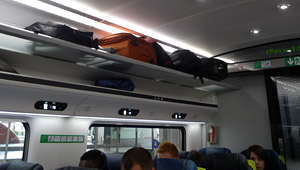 Overhead racks on European trains take small & medium holdalls & suitcases up to & including backpack-size... |
|
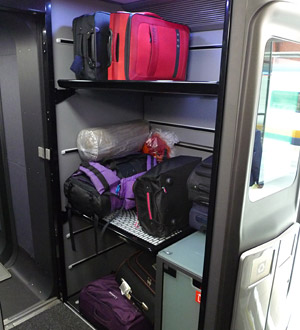 Racks near the entrance doors will take larger items. This is Eurostar. |
|
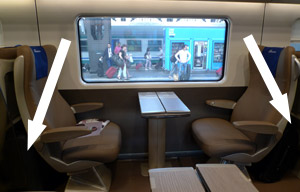 On some trains you can fit a medium suitcase, backpack or holdall between the seat backs. This is an Italian Frecciarossa 1000... |
|
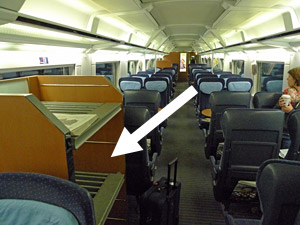
Many trains now have luggage stacks inside the seating area so you can stay close to your bags. |
Luggage on trains is simple
Taking luggage on trains is simple, don't over-think it. You take your bags into the train and put them on the rack above your seat or between the seat backs or on floor-standing racks at the car ends or in the seating area. On local & regional trains you usually just leave bags on the floor. There's no baggage car on most European trains.
For practical purposes there are usually no luggage limits as long as you can carry it yourself. You don't check your bags in, nobody weighs or measures them or argues about size or weight unless you're trying to move house! You have access to your bags during the journey and they don't end up at an airport 1,000 miles away.
Luggage limits on trains
Unlike airlines, for most practical purposes there are usually no size or weight limits or if there are, they're in the small print and pretty generous and in practice nobody weighs or measures bags unless they cause a problem.
Just remember that you have to handle your bags yourself. Porters are a thing of the past and luggage fairies don't exist, so most people now use wheeled luggage.
Eurostar limits luggage to two large items per passenger with a maximum 85cm in any one dimension, plus a small item of hand luggage, but fortunately they're not too fussy about it in practice and won't measure your bags if they're a bit over, nor worry about an extra carrier bag or rolled-up poster or whatever. Indeed why they ever came up with that 85cm is a mystery. See Eurostar website baggage information page.
SNCF (French Railways) now have a formal luggage limit on their TGV InOui trains including Paris-Turin-Milan TGVs, see details here. For Paris-Barcelona TGVs, see details here.
A handful of lo-cost trains have tight luggage limits & fees, these are the 'lo-cost' trains pretending to be budget airlines such as Ouigo in France and Ouigo & Avlo trains in Spain. I'd also check luggage arrangements on Snälltåget between Stockholm, Malmö & Copenhagen and Iryo in Spain. But these are the exceptions, not the rule.
Labelling your bags
You must label your bags when travelling on Eurostar or on any French train with at least your first name & surname - although no-one has ever noticed when I've forgotten. On Eurostar, if you need paper luggage labels ask at the information desk in the departure lounge, but it's better to buy tags and keep them on your bags.
Is your luggage safe?
Overseas visitors often worry about the security of their bags. Those of us who use trains all the time know that luggage theft on trains is as rare as airline baggage theft, padlocking your bags to the racks is a bit extreme.
That said, I always keep my bags where I can see them, my 15 Kg backpack-size bag fits on the overhead rack above my seat or I use a floor-standing rack close to my seat.
It should be obvious, but laptops, passports, iPhones, cameras, wallets and tickets should kept in your daypack with you, not left in your large bag on a luggage rack. You can take your day-pack with you to the toilet or bar car, unless you're travelling with someone who can keep an eye on it for you.
Prohibited items on Eurostar
As you'd expect, firearms & explosives are prohibited on Eurostar (there are special arrangements for sending licensed sporting guns by registered luggage), but several 'normal' street-legal items are prohibited which can catch people out. These include gas canisters (a potential fire hazard in the Channel Tunnel) and knives with a blade longer than 3" which catches out people who buy a set of Sabbatier kitchen knives in Paris. Knives with a blade shorter than 3" are fine, for example small penknives. E-scooters & hoverboards are not carried.
You're allowed to take your own wine or beer on board, but Eurostar may confiscate any 'excessive' alcohol, for example if you look as if you're going to cause trouble. Transporting an unopened bottle or two of vintage wine or single-malt in your luggage should not be a problem.
Mountaineering ice axes have theoretically not been permitted on Eurostar, but in practice have not been a problem, see the traveller's report here, and I'm glad to say that a policy change in late 2013 now means that ice axes properly packed away in your luggage are now officially (as well as in practice) fine on Eurostar.
Registered baggage on Eurostar
Eurostar passengers may send up to 3 items from London to Paris or Brussels as registered baggage at an extra charge, approximately £15-£30 per item, see the Eurostar website baggage information page. However, this service only operates between London, Paris and Brussels, not to other destinations.
Luggage storage at stations: More info
At most major stations you can leave your bags in luggage lockers or a staffed luggage office, leaving you free to explore the city. You'll find details of stations with (and without) left luggage facilities, prices & opening hours, on the left luggage at stations page.
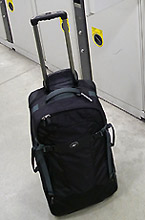 What luggage
do I recommend?
What luggage
do I recommend?
Everyone's needs are different, but I can tell you what suits my wife and me. We each have an Eagle Creek Switchback. It's a roll-along bag with study wheels and extending handle which converts to a backpack with decent back strap system for when the going gets tough. It has a detachable daypack which we use for cameras, documents, reading book and so on. They hold a lot and weigh up to 15 Kg loaded, but are just small enough to fit on the overhead racks above your seat on almost all trains, no need to use the racks at the end of the car. They aren't cheap, but they're top quality and tough, we've used and abused them for years now with not a stitch out of place - though I don't think they're sold any more. If we travel with kids, each kid gets a small holdall which can be slung on a shoulder strap or sat on top of the Eagle Creek bag against the handle.
Pictured right: An Eagle Creek Switchback, handle extended, daypack removed.
Luggage on trains, in pictures
 Racks above your head on most European trains will take small & medium bags, holdalls & suitcases up to & including backpack-sized. This is a London to Paris Eurostar. |
 Racks near the entrance doors will take larger items. This is Eurostar. |
 As well as car-end & overhead racks, on many trains you can fit a medium suitcase, backpack or holdall between the seat backs. This is an Italian high-speed Frecciarossa. |
 Many trains now have luggage stacks inside the seating area so you can stay close to your bags. This is a German ICE train. |

